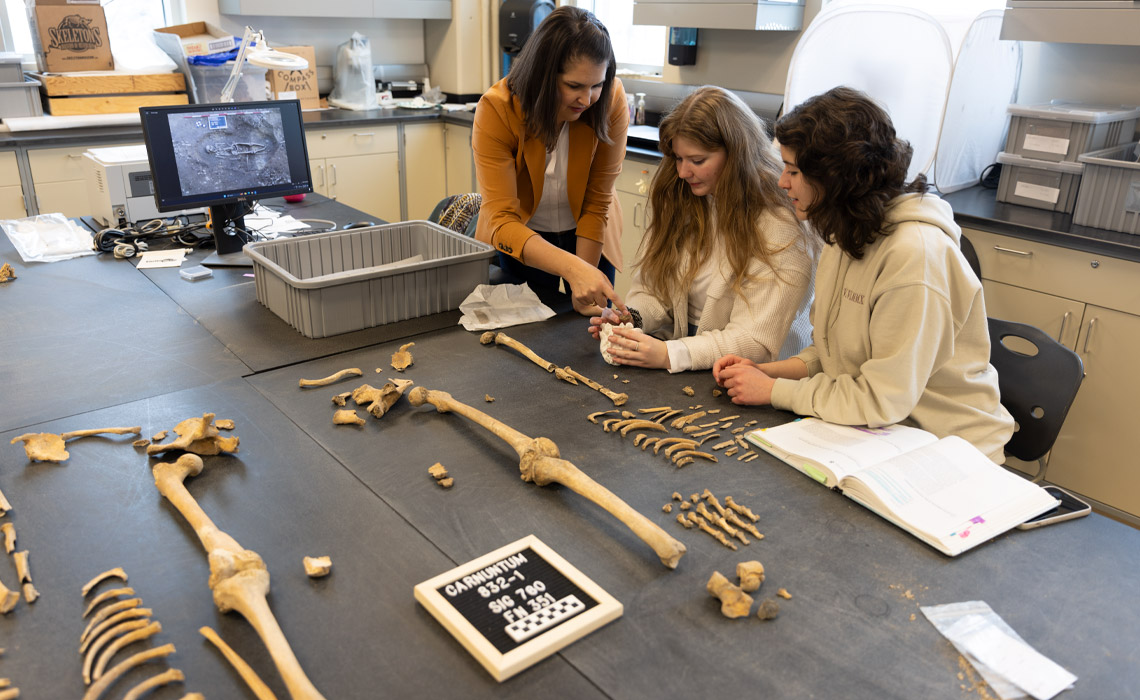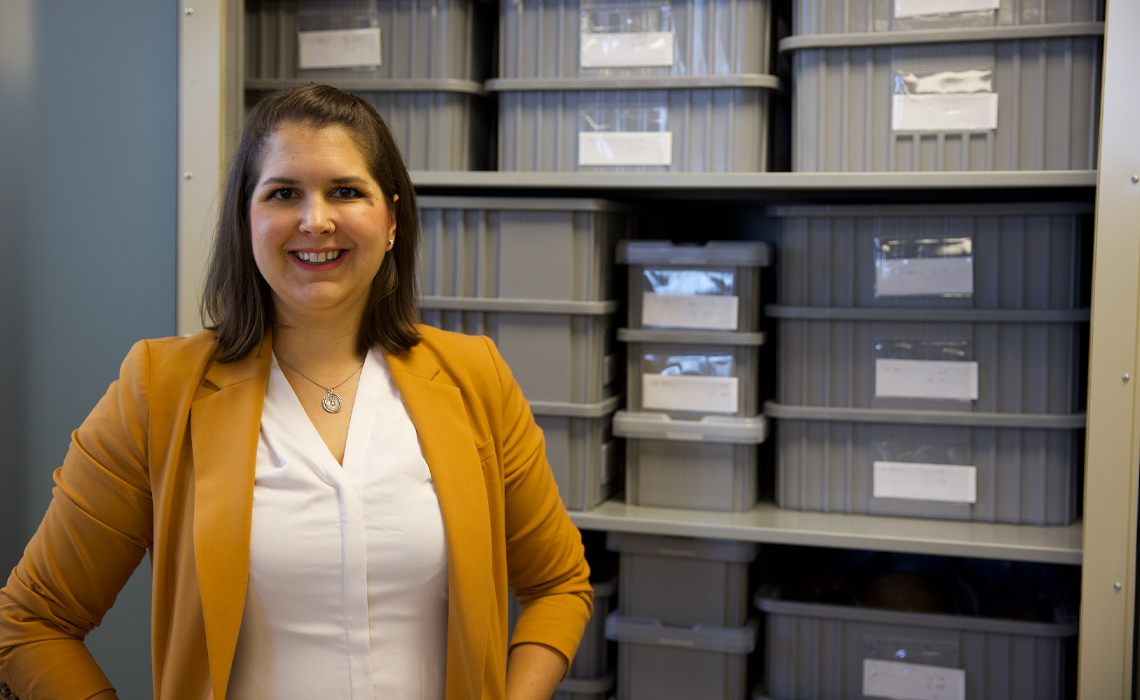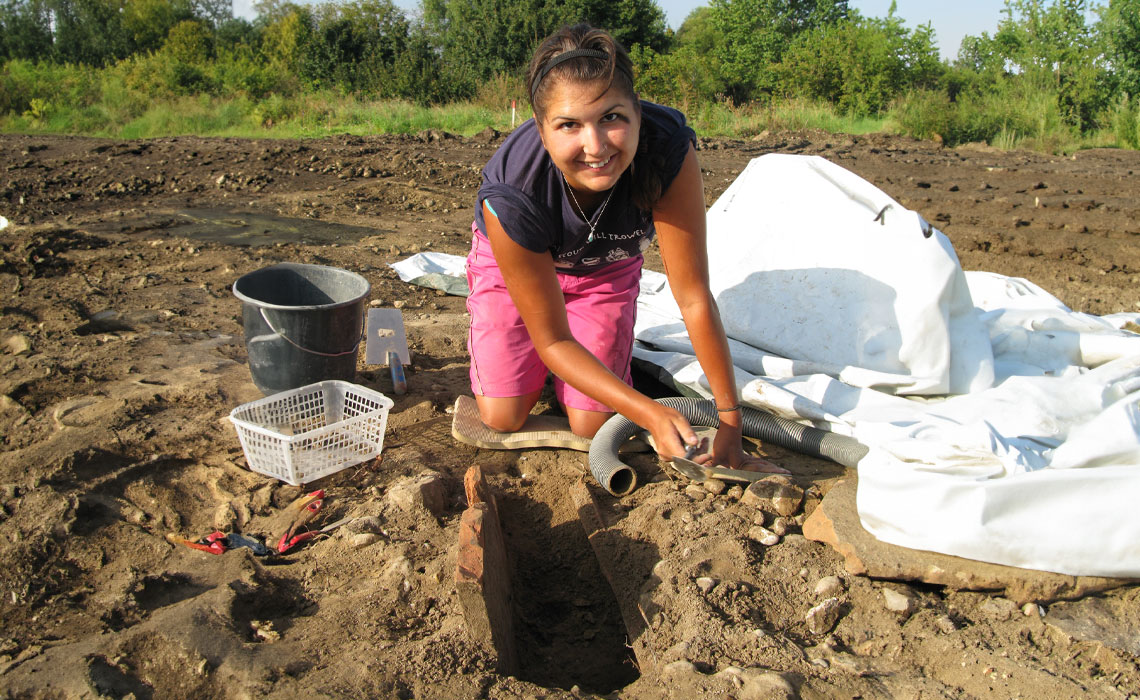From Carnuntum to Calgary

Dr. Rebecca Gilmour, PhD, has been thinking about the Roman Empire long before it was a TikTok trend. In fact, for the assistant professor of anthropology, it is something that has been on her mind for well over a decade. Her dedication and passion for research related to the culture and people from the first century AD and beyond has led to an exciting arrival on campus all the way from Austria.
Roughly 200 Roman-era skeletons have travelled more than 8,000 kilometers and landed at MRU where they will be used for research, teaching and, most importantly, to be preserved and digitized.
“The remains come from Carnuntum, which was a capital city on the edges of the Roman Empire. They are from the first- to fourth-centuries AD, so we’re looking at between 1,500-plus years old," Gilmour explains, who secured the collection on a long-term loan. The loan is in collaboration with the Office of the Lower Austrian Provincial Government Department of Art and Culture and Archäologischer Dienst GesmbH, which is the excavating archaeological firm. Permissions were also granted by the Austrian Federal Monuments Office.
Situated 41 kilometers away from Vienna, Carnuntum was first a “legionary fortress,” but also a “flourishing civilian city” according to the City’s official webpage. The people who lived in this cosmopolitan city, Gilmour says, “were average typical civilians of all ages who held a wide variety of jobs and even moved here from far-away places.” Given their age, many skeletons are not completely preserved, but they still offer an opportunity to know these people who lived on the Roman frontier, including their health, activities and experiences.
Gilmour is in the process of delicately categorizing and taking inventory of each set of remains. They will then be curated in archival boxes, funded by the Faculty of Arts (Arts Endeavour Fund Award). Students will also take part in the research she is conducting, assisting her with documenting preservation on skeletal charts and, where possible, estimating age and sex.
High-level undergraduate research
Having access to a collection of this size and from Europe is not common. In fact, department chair Dr. Mary-Lee Mulholland, PhD, says the loan of these skeletons to MRU is a “once-in-a-lifetime opportunity.”
“The ability to work directly with ancient skeletons is a rare and invaluable experience offered to few undergraduate-level students. This collection will be the foundation of many high-impact pedagogical practices including primary data collection and analysis, applied anthropology and independent research.”
It will be used in the classroom as well, Mulholland says, adding that Gilmour has already selected more than dozen volunteers and has hired a trio of research assistants to work with her. “I cannot overstate the excitement that students have to be able to learn from this valuable collection.”
Beyond the MRU community, once an all-encompassing inventory has been completed the collection may be used by visiting researchers as well as students completing their masters and doctorates. “I want this collection to be an opportunity for our students, other researchers, and for my own research too,” Gilmour says. She is currently working on a research project that investigates how these people, living in a city on the edges of the Roman Empire, experienced and were affected by broken bones and arthritic joints.
Understanding the past for a better future
One of the most important projects Gilmour is undertaking with this collection is placing a 3D-scan of every bone of each skeleton into a database accessible to students. This provides learners with a digital resource to supplement what they have learned in class. The hope is that eventually this database will also be accessible to the local community that lent the materials in the first place and ideally featured in a publically available online exhibit, as well as be made available for bioarchaeological research.
Eventually, with help from Archeological of Alberta — Calgary Centre, Gilmour is going to develop and host community workshops related to the Roman remains. “These will be educational workshops that teach community members about bioarchaeology — how to read the evidence preserved in our skeletons.”

Understanding lived experiences of people in the past means we can better understand humans in the present, Gilmour explains. “Knowing how people in different socio-cultural contexts and times responded to their health may help the public relate to their own experiences of injury and impairment and think about recovery in different ways. So, although these are ancient people, what we can learn about their health can help us understand our own.”
The remains that are on campus now are only about 70 per cent of what Gilmour was offered on loan, and she plans to go back and collect the rest to keep the collection unified.
The journey to MRU
“It is impossible to capture the amount of labour and dedication that Dr. Gilmour has poured into bringing this collection to Mount Royal,” Mulholland says.
Unknowingly, the journey to MRU started long before Gilmour was a professor here. After graduating high school, she took part in a Rotary Exchange Student program and spent time in Vienna, Austria, where she learned German. A few years later while finishing her undergraduate at Simon Fraser University, the professor supervising her honours thesis suggested that Gilmour connect with an exchange student from Vienna who was also studying bioarchaeology.
The student had returned home but Gilmour was set to soon be in Austria for a personal trip.
“We met for coffee and then we spent about a week volunteering together washing skeletons.”
Gilmour knew it would be good, hands-on experience, but at the time wasn’t expecting much to come from it. After finishing her bachlor’s, she took a chance and called the same company she had volunteered with. As luck would have it, the archeology company had a job opening. Gilmour obtained a student work visa and off she went again to Austria.
“I spent the summer of 2008 excavating Roman period remains and artifacts in Carnuntum (modern day Petronell-Carnuntum). I started at an equestrian camp, so we were excavating the stalls where the horses and the soldiers would have lived,” Gilmour explains.
The work she was doing was not research based, it was contract archaeology, meaning the land was set to be developed so the area had to be excavated and the findings documented. After the work at the equestrian camp wrapped up, Gilmour went on to work on a cemetery site where she excavated the remains of a couple hundred people.
Little did she know it was just the start of a long journey that would see her eventually be reunited with those exact same skeletons.

Following her summer job, Gilmour began her master’s program in the U.K. and eventually started working on her PhD. She knew she wanted to continue studying Romans,specifically looking at trauma, impairment and illnesses. As part of her research, she wanted to see if she could access the remains she had excavated a few years before.
“They had been in storage and hadn’t been analyzed or accessed since we had excavated them in 2008,” Gilmour says, adding that contract archaeology generally covers the excavation, the documentation and a basic report, but it often doesn’t allow for more comprehensive analyses.
Knowing what a unique collection this was, she contacted the appropriate people and ended up going back to Austria in 2014 to conduct trauma analysis on as many of the adults as she could. The remains then went back into storage and Gilmour completed her doctorate.
Then she started working at Mount Royal, and “that really opened up the doors” for her to do more work.
“With remains like these, the European feeling is generally positive towards the archeological assessment and the analysis of the Roman period in Austria,” she says, noting that in her role at MRU she felt that there could be a place to use them for instruction and research.
And with that, she started the arduous task of obtaining permission and approvals from all levels of government both here at home and abroad to have the remains she had excavated with the archaeological contracting company back in 2008 borrowed on a long-term loan.
It was a nerve-wracking experience, and one that was new for Gilmour. It required back-and-forth trips between Calgary and Austria, approvals from all levels of government on each end, specific packaging, and even specific transport.
To say things have come full circle for Gilmour and these remains might be an understatement. She has worked with them in some way at almost every step in her academic career and is now getting to do further research on them and use them in the classroom.
“To see the excavation reports that I filled out in my very terrible German,” she laughs, “I have done the preliminary on-site estimations on age and sex and now I have them here and I get to share all of that with my students.”
Gilmour says she would be remiss if she didn’t credit Roman Igl (the site’s excavating archaeologist) and ARDIG, the contract archaeological company she worked with in Austria, because “without those people being behind this, none of this would have been possible.”
Learn more about Mount Royal’s Bachelor of Arts – Anthropology degree program.
